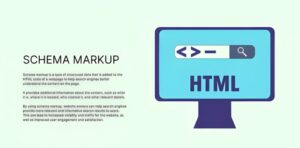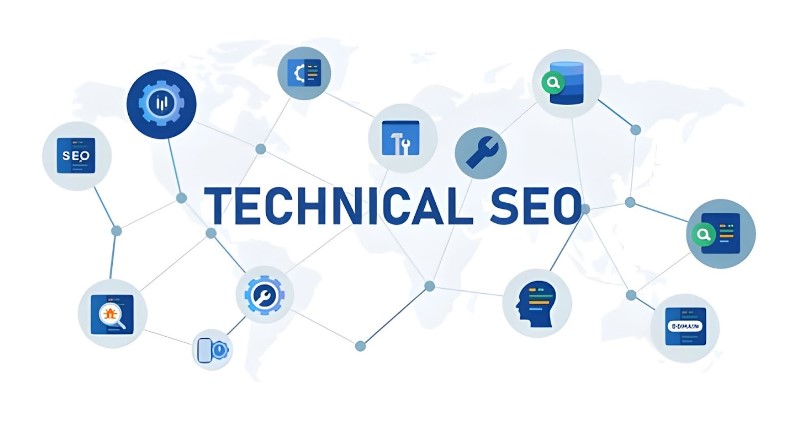Technical SEO best practices include optimizing site speed, ensuring mobile-friendliness, and improving crawlability. Secure your site with HTTPS and implement structured data.
Optimizing your website for technical SEO is crucial for better search engine rankings. Focus on improving your site’s speed, as fast-loading sites rank higher and enhance user experience. Ensure your website is mobile-friendly because most users access the internet via smartphones.
Improve crawlability by fixing broken links and creating a clear sitemap. Use HTTPS to secure your site, which builds trust with users and search engines. Implement structured data to help search engines understand your content better. These practices not only improve your site’s visibility but also boost user engagement and satisfaction. Consult a technical SEO expert to ensure your site adheres to the latest best practices.
Introduction To Technical SEO
Technical SEO is the backbone of a well-optimized website. It focuses on improving the technical aspects to enhance search engine indexing and ranking. A technically sound website ensures a better user experience and higher visibility.
Importance Of Technical SEO
Technical SEO is crucial for several reasons:
- Improves website speed: Faster websites rank higher and retain users longer.
- Enhances crawlability: Search engines can crawl and index content more efficiently.
- Boosts mobile-friendliness: Mobile-friendly sites perform better in search results.
- Fixes broken links: Reduces errors and enhances user experience.
- Optimizes URL structure: Clean and descriptive URLs improve search engine visibility.
Key Components
Understanding the key components of technical SEO helps in optimizing a website effectively:
| Component | Description |
| Website Speed | Fast loading times improve rankings and user engagement. |
| Mobile Optimization | Ensures the site is accessible and functional on mobile devices. |
| SSL Certificate | Secure sites with HTTPS are trusted by users and search engines. |
| XML Sitemap | Helps search engines understand the site’s structure and content. |
| Robots.txt File | Guides search engine crawlers on which pages to index. |
These components form the core of technical SEO. They lay the foundation for a well-optimized and high-ranking website.
Website Crawling And Indexing
Website Crawling and Indexing are vital for SEO success. Search engines use crawlers to explore your site. They then index the content. Ensuring efficient crawling and indexing boosts your site’s visibility.
Crawl Budget Optimization
The crawl budget is the number of pages a search engine crawls. Optimize it for better indexing.
- Fix broken links
- Remove duplicate content
- Update outdated pages
- Improve site speed
Use Google Search Console to monitor crawl stats. This helps in identifying issues.
Robots.txt Configuration
Robots.txt tells search engines which pages to crawl. Proper configuration ensures vital pages are indexed.
Example of a basic Robots.txt file:
User-agent:
Disallow: /private/
Allow: /public/
Disallow sensitive areas like admin sections. Allow important content to be indexed.

Site Structure And Navigation
Creating a strong site structure and navigation is crucial for effective Technical SEO. It helps both users and search engines find and index your content. A well-organized site makes it easy to navigate and improves user experience. Below are some best practices for optimizing your site structure and navigation.
Url Structure
A clean and organized URL structure is essential for SEO. URLs should be simple, descriptive, and easy to read. Follow these tips for effective URL structure:
- Use hyphens to separate words (e.g., example.com/technical-seo-best-practices).
- Keep URLs short and relevant.
- Include keywords in the URL.
- Avoid using special characters or numbers.
For example:
| Good URL | Bad URL |
| example.com/technical-seo-tips | example.com/page123 |
| example.com/site-structure-guide | example.com/?p=456 |
Internal Linking Strategies
Effective internal linking improves site navigation and distributes link equity. Follow these strategies for internal linking:
- Use descriptive anchor text.
- Link to relevant pages within your site.
- Ensure every page is reachable in 3 clicks or less.
- Update old content with links to new content.
For example:
If you have a blog post about SEO tips, link it to a related post on keyword research. This creates a network of related content, making it easier for users and search engines to find and navigate your site.
Mobile Optimization
Mobile optimization is crucial for technical SEO. It ensures your site is user-friendly on mobile devices. Google prioritizes mobile-friendly sites in search rankings. Let’s explore essential practices for effective mobile optimization.
Responsive Design
A responsive design adjusts your website’s layout based on the screen size. This means your site looks great on all devices. Users will have a seamless experience on a phone, tablet, or desktop.
Use the following tips for responsive design:
- Utilize fluid grids that scale with screen size.
- Employ flexible images to avoid overflow issues.
- Apply media queries to adjust styles for different devices.
Here is a simple example of a responsive design code:
@media only screen and (max-width: 600px) {
.container {
width: 100%;
}
}
Mobile-first Indexing
Mobile-first indexing means Google uses the mobile version of your site for ranking. Ensure your mobile site is as complete as the desktop version. Missing content can hurt your rankings.
Follow these steps for mobile-first indexing:
- Ensure all content is visible on mobile.
- Optimize loading speed for mobile pages.
- Use structured data on mobile and desktop versions.
- Verify meta tags are consistent across versions.
Below is a table summarizing key mobile-first indexing practices:
| Practice | Description |
| Content Visibility | Ensure all content is accessible on mobile. |
| Loading Speed | Optimize images and code for faster loading. |
| Structured Data | Keep structured data consistent on all versions. |
| Meta Tags | Check that meta tags are the same on mobile and desktop. |
Page Speed And Performance
Page speed and performance are crucial for a successful website. Faster loading times improve user experience and search engine rankings. Optimizing your site’s speed can lead to higher engagement and conversions. Let’s dive into some best practices for enhancing your page speed and performance.
Core Web Vitals
Core Web Vitals are essential metrics for page speed. They measure how users experience your site. There are three key metrics:
- Largest Contentful Paint (LCP): Measures loading performance. Aim for 2.5 seconds or faster.
- First Input Delay (FID): Measures interactivity. Aim for less than 100 milliseconds.
- Cumulative Layout Shift (CLS): Measures visual stability. Aim for a score of less than 0.1.
Google uses these metrics to rank your site. Ensure your site performs well in these areas.
Image Optimization
Images can significantly slow down your site. Optimizing images can improve load times. Here are some tips for image optimization:
- Use the correct format: JPEG for photos, PNG for graphics, and SVG for icons.
- Compress images: Use tools like TinyPNG or ImageOptim.
- Lazy load images: Load images only when they appear in the viewport.
- Use responsive images: Serve different sizes based on the user’s device.
Optimized images reduce load times and enhance user experience.
| Image Format | Best Use |
| JPEG | Photographs |
| PNG | Graphics and Icons |
| SVG | Scalable Icons and Logos |
Choosing the right image format is crucial for performance.

Secure Website Protocols
Secure website protocols are crucial for technical SEO. They protect user data and build trust. A safe site also ranks higher on search engines. Let’s explore key practices for secure website protocols.
Https Implementation
HTTPS stands for HyperText Transfer Protocol Secure. It encrypts the data sent between the user and the website. This makes it hard for hackers to intercept the data.
Implementing HTTPS is simple:
- Purchase an SSL certificate.
- Install the certificate on your web server.
- Update your website links to HTTPS.
- Set up 301 redirects from HTTP to HTTPS.
SSL Certificates
SSL stands for Secure Sockets Layer. An SSL certificate ensures secure connections. It shows a padlock icon in the browser bar.
There are different types of SSL certificates:
| Type | Description |
| Single Domain | Secures one domain name. |
| Wildcard | Secures one domain and unlimited subdomains. |
| Multi-Domain | Secures multiple domain names. |
Choose the right SSL certificate for your website. Ensure it matches your needs.

Structured Data And Schema Markup
Structured data and schema markup are vital for SEO. They help search engines understand your content better. This leads to improved visibility and higher rankings. Using structured data, you can enhance your site’s appearance on SERPs.
Rich Snippets
Rich snippets provide extra information about your site. They appear directly in search results. Rich snippets can include:
- Ratings
- Reviews
- Prices
- Availability
Adding rich snippets can boost your click-through rate. Users get more information at a glance. This makes your site more appealing.
Json-ld And Microdata
There are two popular methods for adding structured data: JSON-LD and Microdata. Both have their advantages.
| Method | Advantages |
| JSON-LD |
|
| Microdata |
|
Choosing the right method depends on your site’s needs. JSON-LD is often easier and cleaner. Microdata can be useful for simpler projects.
Technical SEO Tools
Technical SEO tools help improve website visibility on search engines. These tools analyze and optimize various elements of a website. They are essential for identifying issues and enhancing performance.
Google Search Console
Google Search Console is a free tool by Google. It helps monitor and maintain a site’s presence in search results.
- Submit sitemaps: Ensure all pages are indexed.
- Check crawl errors: Identify issues preventing Google from crawling.
- Analyze search traffic: Understand user queries and impressions.
- Mobile usability: Ensure the site is mobile-friendly.
Third-party SEO Tools
Various third-party tools offer features beyond Google Search Console. They provide deeper insights and advanced functionalities.
| Tool | Features |
| SEMrush |
|
| Ahrefs |
|
| Screaming Frog |
|
These tools provide a comprehensive view of a site’s technical health. They help in making data-driven decisions for SEO.
Regular Audits And Monitoring
Regular audits and monitoring are crucial for maintaining a healthy website. They help you identify and fix issues before they impact your rankings. By conducting regular audits, you can avoid potential problems and ensure your site remains optimized for search engines. Consistent monitoring allows you to keep track of your website’s performance and make adjustments as needed.
SEO Auditing Tools
Several tools can assist in conducting thorough SEO audits. These tools help identify technical issues affecting your site’s performance. Here are some popular options:
- Google Search Console: Provides insights into your website’s performance, indexing status, and potential issues.
- SEMrush: Offers comprehensive site audits, including on-page SEO analysis and backlink audits.
- Screaming Frog: Crawls your website to identify broken links, duplicate content, and other technical issues.
- Ahrefs: Analyzes your website’s health and provides detailed reports on various SEO metrics.
Performance Tracking
Monitoring your website’s performance is essential for maintaining its SEO health. Use the following methods to keep track of your website’s progress:
- Google Analytics: Tracks traffic, user behavior, and conversion rates. Provides valuable data for understanding your audience.
- Page Speed Insights: Analyzes your website’s loading speed. Offers suggestions for improving performance.
- Mobile-Friendly Test: Ensures your site is optimized for mobile devices. Identifies issues that could affect mobile users.
- Heatmaps: Tools like Hotjar show how users interact with your site. Helps identify areas for improvement.
Regular audits and monitoring are key to long-term SEO success. Use the right tools and stay vigilant to keep your website in top shape.
Frequently Asked Questions
What Are The Most Important Technical Things In SEO?
Key technical SEO factors include website speed, mobile-friendliness, secure HTTPS, clean URL structures, and proper use of meta tags. Regularly update XML sitemaps and ensure proper indexing. Optimize images and use schema markup. Prioritize internal linking and fix broken links.
What Are The Steps For Technical SEO?
- Conduct a website audit. 2. Optimize site speed and performance. 3. Ensure mobile-friendliness. 4. Implement structured data. 5. Fix broken links and improve site architecture.
What Is A Technical SEO Checklist?
A technical SEO checklist ensures your website is optimized for search engines. It includes improving site speed, fixing broken links, and enhancing mobile usability.
What Is A Technical SEO Specification?
A technical SEO specification outlines guidelines for optimizing a website’s technical elements. It includes directives on site speed, mobile-friendliness, crawlability, and structured data. This helps improve search engine rankings and user experience.
Conclusion
Mastering technical SEO is crucial for website success. Implement these best practices to improve search engine rankings and user experience. Stay updated with the latest trends, monitor performance, and make necessary adjustments. Consistent effort in technical SEO will yield long-term benefits for your site’s visibility and traffic.

